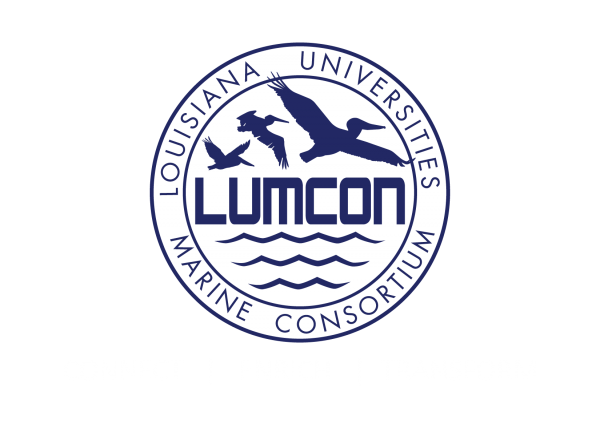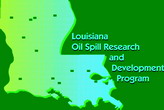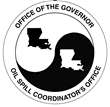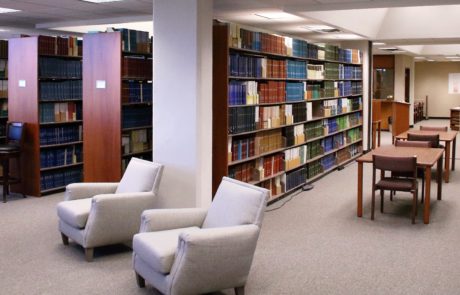LIBRARY
MAIN CATALOG (Electronic Resources/LUMCON Library)
Click here to search the Dispersants Bibliography
Click here to search Effects of Offshore Oil and Gas Development Bibliography
ABOUT THE LIBRARY
The LUMCON Library collection was originally housed in Ellender Memorial Library, located at Nicholls State University in Thibodaux, Louisiana. After completion of the DeFelice Marine Center in 1986, the collection was moved to its present location. Since that time, the Library has become an active resource center for LUMCON faculty and staff as well as Consortium member institutions, visiting researchers, students, and the public.
The library contains a computer lab and several study spaces available to visiting students, scientists, or groups (such as attendees of a writing retreat).
The collection and development of library materials reflects LUMCON’s research programs. The collection has approximately:
- 4,600 monographs
- 5,800 bound volumes
- 200 journal titles
- 26 current journal subscriptions
- 850 maps
- 35 atlases
- 3,600 government documents
- 1,500 reprints
In addition, the library houses a complete collection of research products generated by DeFelice Marine Center personnel since LUMCON’s inception.
HOURS OF OPERATION
- The LUMCON Library is staffed Monday through Friday from 7:00 AM to 3:30 PM. All visitors are welcome during these hours.
- The Library is closed to the public on weekends, state holidays, and when the librarian is not on site. Before visiting the facility, please call 985-851-2875 to ensure the Library will be open.
- All LUMCON staff, summer students, and resident visitors have 24-hour access to the Library. If the doors to the Library are locked, the security guard will open them for you.
CIRCULATION
- Books can be checked out by filling out a card at the circulation desk. The length of time a book can be checked out varies depending on the patron’s status. Books may be renewed by contacting the department, but all items are subject to recall at any time.
- Interlibrary loan service is available for LUMCON faculty, postdocs, lab personnel, and summer students. Although we strive to get items at no charge, the patron may be asked to pay for interlibrary loan charges under certain circumstances.
- Reserve items, reference materials, and journals must remain in the Library. The Library has no photocopier, but copies or scans can be made in the LUMCON main office.
- All materials must be checked out before removal from the Library, without exception.
- Library materials can be placed on reserve for summer classes. A list of items to be placed on reserve should be provided to the librarian as soon as possible.
- When returning material that has been checked out, please drop off items at the circulation counter.
Food is not allowed in the Library under any circumstance. Drinks are only allowed with prior approval by the librarian or the security guard.
INTERNSHIP PROGRAM
The LUMCON Library is available as an internship site for graduate-level students who have completed at least two semesters toward a Master’s degree in Library and Information Science. Applications will be accepted on a continuing basis and internships may be completed during any semester. Prior library experience or an undergraduate degree in science is desirable, but not necessary. Credits will be awarded based on the number of person-hours completed (40 person-hours per credit hour).
The internship will consist of both field experience, encompassing many operations of a special library, and a special project in technical services. The Librarian will give the intern an overview of reference services, technical services, library administration, and budgeting, and will guide the intern through special projects. The LUMCON Library uses SIRSI/Dynix’s Symphony Integrated Library System as well as OCLC for Cataloging/Interlibrary Loan services.
Contact the Librarian for more information or to apply for an internship.
ACKNOWLEDGMENTS
We would like to thank the following individuals for their guidance and input when creating the Dispersants Bibliography:
-
- Victoria Broje, Per Daling, Alun Lewis, and Francois-Xavier Merlin offered valuable assistance in the early phases of this project. Per Daling’s support was especially noteworthy, by providing conference proceedings that otherwise could not be obtained.
- Deborah Ansell, ITOPF’s librarian, contributed by sharing her sizeable list of library holdings on dispersant publications with us, and filling in gaps where existing citation information was incomplete.
- Likewise, Julie Anne Richardson, librarian for Environment Canada, compiled a publication listing on dispersants housed in her collection, which provided us with additional citations for our project.
- Qianxin Lin at Louisiana State University provided API conference proceedings for us to use in transcribing abstracts.
- Nancy Kinner at the Coastal Response Research Center provided encouragement, focus, and connected us with some of the aforementioned people.
- Finally, Don Davis and Karen Reeder Emory at OSRADP deserve special mention for all of their help and direction during the span of this project.
 |
 |
 |
The LUMCON Library is a member of the International Association of Aquatic and Marine Science Libraries and Information Centers (IAMSLIC), the Southeast Affiliate of IAMSLIC Libraries (SAIL), and the Louisiana Library Network and Information Consortium (LOUIS). Additionally, the Library has access to OCLC Cataloging/Interlibrary loan services.
Click here to search LUMCON’s e-Library catalog using the LOUIS portal.
DISPERSANTS BIBLIOGRAPHY
In mid-1972, the Environmental Emergency Branch was formed within the Canadian Department of the Environment to be responsible for protective and preventative activities related to pollution emergencies, including oil spills. The technology development work carried out by the branch can be divided into two main programs. One is the testing, evaluation, and development of oil spill countermeasures equipment, materials, and techniques. Examples of this research are given. The other main responsibility is to design and develop various countermeasures systems for specific high risk and sensitive areas in Canada. Four areas presently being thoroughly investigated are Vancouver Harbour, the Beaufort Sea, the St. Clair River, and the St. Lawrence River. Much of the technology development and research effort in Canada has been directed toward cold environment problems, drilling blowouts in the Arctic, pipeline spills under winter conditions, dyking of storage facilities in the north, and spills in ice-infested water
The paper consolidates the findings of a number of projects recently completed at S.L. Ross Environmental Research, Ltd. that provide new information on dispersant use, particularly in the area of vessel-based application systems. Included are discussion of: (1) various advantages that vessel-based systems have over aircraft-based systems in certain spill situations; (2) comparison of application platforms over a range of spill scenarios; (3) recent research on single-nozzle dispersant application systems for use on vessels; and (4) a recent study showing the potential inefficiencies associated with the application of popular modern dispersants in diluted form
The Minerals Management Service (MMS), U.S. Department of the Interior, operates a wave tank facility in Leonardo, New Jersey known as OHMSETT (Oil and Hazardous Material Simulated Environmental Test Tank), which is used primarily for testing oil spill booms and skimmers. This paper summarizes two studies undertaken to examine the feasibility of testing dispersants at the facility as well. The first study included: (1) interfacial tension laboratory tests, (2) turbidity tests, (3) laboratory test to evaluate filtering materials for removing dispersant and chemically dispersed oil, and (4) full-scale evaluation testing at OHMSETT. The results indicated that dispersant testing at OHMSETT could be done with good success if the testing program were carefully designed and implemented. It was determined that a number of dispersant tests could be conducted over several days, after which the tank water would have to thoroughly cleaned to remove dispersed oil (with a cellulose-based filter) and dispersant (with an activated carbon system). Following the feasibility study, the project moved to the second study, namely the design and validation of an experimental protocol for dispersant effectiveness testing at the facility. Full-scale tank work was conducted in April 2000. Preliminary results, provided in this paper, indicated that OHMSETT is an attractive facility for determining dispersant effectiveness
A computerized system to aid in making real-time dispersant-use decisions for oil spills in the U.S. Gulf of Mexico is under development and due for completion in early 1988. The system can predict the impact of an oil spill in the Gulf if it is either treated with dispersants of left untreated. The method works as follows. A computerized map of the untreated spill is produced showing the predicted location and concentration of the spilled oil as a function of time after the initial discharge. This map is then compared with a series of computerized maps of 70 important Gulf resources that might suffer from the effects of the spill. A geographical information system (GIS) with extensive spatial analytical capabilities is then used to calculate the proportion of each resource that is affected by the spill at specified levels of oil concentration
Dispersant use is a factor that may partly determine the fate and effects of spilled oil. A series of quantitative field experiments has been initiated to simulate conditions following nearshore treatment of a floating oil slick or following the cleaning of a spill stranded on the shore. The basic experimental design is a series of treatments (Forties or Nigerian crude oil, BP 1100WD dispersant, or oil plus dispersant) applied to sets of experimental plots in a range of intertidal and subtidal communities. Biological recording includes frequency and density measurements of plants and animals, and hydrocarbon analysis is by capillary gas liquid chromatography and computerised gas chromatography-mass spectrometry. Additionally, the effects of dispersant on the movement and fate of oil in different types of sediment is being investigated using a laboratory sediment column and controllable temperature seawater system. The columns have been successfully used in the modeling of low-energy sedimentary environments. Particular attention has been paid to the nature of water table fluctuations within the sediment, to grain size and sorting, to permeability, and also to the number of simulated “tides” that the columns experience after treatment. Hydrocarbon analysis is primarily by ultraviolet spectrophotometry, which has the advantage that the large number of samples generated by each experimental run can be quickly analysed. Gas liquid chromatography is used for checking selected samples. Preliminary results from the field and laboratory experiments indicate that some dispersant treatments increase penetration of oil, and that it may be retained below the sediment surface. Interacting factors include time of treatment in relation to tidal cycle and behavior of the water table in the sediment
Governments and industry, both national and international, contend that dispersants are an effective and practical response option under certain circumstances. However, a comprehensive training and education program in dispersant operations used to establish a baseline of understanding between responders and stakeholders is lacking. Dispersant operations have played a positive and significant role on numerous oil spills in both national and international waters, yet a curriculum in dispersant operations remains a minor component of oil spill response course curricula. This may suggest that decision makers, responders and ultimately the public and environment are being shortchanged of alternative response technology training and education, which essentially fails to meet the needs of regional response teams, area committees, natural resource trustees, and the general oil spill response community’s future decision makers. Supported through case study analyses and critical argumentation, this paper presents an oil spill dispersant operations curriculum that governments and industry, both national and international, can adopt
This database consists of citations found in journals, conference proceedings, government reports and gray literature covering over 40 years of published research on oil spill dispersants. Citations were collected from 1960 through June 2008. This bibliography was compiled and edited by John Conover, Associate Librarian at LUMCON, and funded by a grant from the Louisiana Applied and Educational Oil Spill Research and Development Program (OSRADP).
EFFECTS OF OFFSHORE OIL AND GAS DEVELOPMENT BIBLIOGRAPHY
|
Quarterly Issues
|
Compilations
|
- Biology
- Ecological, anatomical, and physiological effects of oil and/or gas, Species as biomarkers, PAH uptake and bioaccumulation, etc.
- Chemistry/Geochemistry/Geology
- Biochemistry, Biodegradation, Bioremediation, Hydrocarbon degradation, Environmental sampling, Soil contamination, etc.
- Engineering/Physics
- Technological advancements in facility/equipment design and use, Spill response and recovery equipment, Physical properties of oil and gas, etc.
- Environment/Ecosystem Management/Spills
- Environmental assessment and management, Oil and/or gas spill description and analysis, etc.
- Socioeconomic/Regulation/General
- Social and economic ramifications, Politics, Governmental policy and legislation, Organizational policy, General interest, etc.
This bibliography is a quarterly compilation of current publications (citations with abstracts) from a wide variety of electronic and print information sources relating to offshore oil and gas development. It is compiled and edited by John Conover, Associate Librarian at LUMCON. Items listed may or may not be available at the LUMCON Library. Items without annotations were unavailable for perusal prior to publication.
All questions about using library facilities, locating library resources, or searching LUMCON catalogs should be directed to the Librarian.


